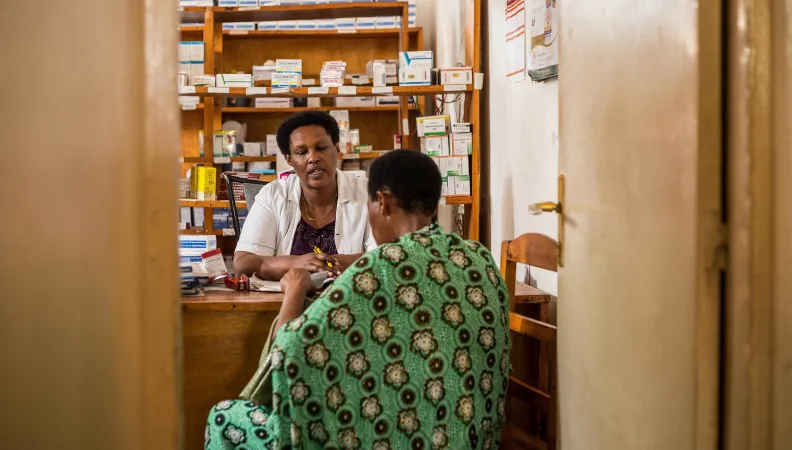 Africa remains a young continent. However, the ongoing demographic transitions are accompanied by an anticipated aging population — and in some countries, this process has already begun. Although a wide variety of situations coexist across the continent, the growing number of older people will require significant adjustments to public policies, including fiscal, health, and social measures.
Africa remains a young continent. However, the ongoing demographic transitions are accompanied by an anticipated aging population — and in some countries, this process has already begun. Although a wide variety of situations coexist across the continent, the growing number of older people will require significant adjustments to public policies, including fiscal, health, and social measures.
Context
In many African countries, older people still represent a very small share of the population (3% in sub-Saharan Africa and 5.6% in North African countries). For a long time, they have been largely overlooked by public policies, which have focused instead on the most urgent needs of economic, social, and health development — primarily targeting children and young adults.
However, the number of older people is increasing — not only in absolute terms but soon also in relative terms, with aging projected to occur more rapidly than in other regions. The challenge now is to design and implement appropriate public policies to support this demographic shift, particularly in the areas of health and social protection.
New forms of coverage and protection are emerging — or becoming essential — such as cash transfers, which complement family-based solidarity systems, free healthcare and services for older adults, the expansion of so-called universal pension and retirement schemes, and more broadly, private support systems on which most older people on the continent must still rely.
Objectives
This research project provides a framework for understanding population aging and related public policies across the African continent, from a comparative perspective. It examines the aging process, its associated challenges, the public policies addressing it, and the institutional frameworks in various countries, focusing on emblematic case studies that reflect diverse situations (South Africa, Cameroon, Cape Verde, Kenya, Morocco, and Senegal). The project also includes targeted analyses based on recent data, highlighting the contributions of demographic research to issues of health and social protection (notably pensions) for older adults.
The project resulted in a valuable overview for policymakers in AFD’s partner countries, contributing to broader reflections on the conditions under which different public policy models may or may not be replicated across the African continent.
Method
The project is based on a comparative analysis of secondary demographic data drawn from existing sources — including research papers, reports, and scientific literature. By presenting the different trajectories of demographic transitions, it offers an overview of aging across the continent, including its timing and context, and explores the associated challenges for both national and local public policies. It highlights regional, national, and subnational variations in aging, in order to identify the areas that are either most advanced in this process or experiencing the fastest pace of change.
Focused case studies on a selection of countries representing different situations provide a systematic critical review along the following lines:
- a socio-demographic and health overview;
- a description of the institutional framework and public policies in place;
- a critical analysis of the social and health-related challenges of the aging process;
- and an exploration of how aging is transforming family structures — particularly regarding intergenerational transfers, migration patterns, and women’s labor participation.
Results
The research project led to the following publications:
- The publication of the research paper “Africa Facing Its Aging Population: What Are the Challenges for Public Policy?” (in French, June 2024);
- The release of “How can healthcare for older people in sub-Saharan Africa be improved?” (April 2024);
- The publication of “Health Statistics on Older Adults in Sub-Saharan Africa: A Literature Review” (in French).
In July 2023, a webinar from the Research Conversations series presented the project’s initial findings (in French only):
Research findings
Africa is expected to face the challenge of an aging population in the coming decades. The first and foremost challenge lies in expanding social protection coverage, which is currently the lowest in the world: only 17% of the population is covered. This low rate is partly due to the predominance of the informal economy, which hinders the development of a contributory social protection system — particularly in rural areas. There is now a pressing need to strengthen public policies aimed at expanding social protection to a broader share of the population, both in rural and urban areas.
However, the evolution of social protection systems — particularly in health and pensions — rests on several key pillars that remain uncertain and have historically been prerequisites for their expansion:
- First, the effective collection and use of tax revenues to finance social protection;
- Second, the promotion of stronger links between pension and health coverage;
- And finally, sustained economic growth driven by a development model — historically industrial and manufacturing-based — that enabled the establishment of such public policies.
Yet in Africa, this economic model, centered on formal employment, has not taken root. Moreover, the impacts of climate change are raising fundamental questions about this development path, making it even more difficult to design and implement aging-related public policies — just as they are becoming increasingly necessary.
READ OUR RESEARCHER'S INTERVIEW
Serge Rabier: ‘Many African Countries Have No Social Protection Programmes For Elderly’
Want to stay updated on AFD’s latest research?
 As part of this research project, AFD is working with the Biotope/Arcadis consortium to identify the best methods for measuring biodiversity – or "biodiversity metrics" – for Public Development Banks (PDBs). This project aims to strengthen the mainstreaming of biodiversity criteria into financing decisions, thereby contributing to a more nature-positive economy.
As part of this research project, AFD is working with the Biotope/Arcadis consortium to identify the best methods for measuring biodiversity – or "biodiversity metrics" – for Public Development Banks (PDBs). This project aims to strengthen the mainstreaming of biodiversity criteria into financing decisions, thereby contributing to a more nature-positive economy.
Context
Today, the loss of biodiversity has become a major risk for financial systems. In September 2023, Ravi Menon, Chairman of the NGFS – the network of central banks, financial regulators and financial institutions for the greening of the financial system – warned: "Along with the climate crisis, the degradation of nature is an existential threat facing our planet. Addressing nature-related risks and its broader implications for the financial sector is no longer just prudent – it is an imperative".
As these risks require rigorous measurement, several frameworks have been proposed. The NGFS has published a conceptual framework for taking into account the risks associated with biodiversity loss. Target 15 of the Kunming Montreal Global Biodiversity Framework also encourages businesses and financial institutions to assess, report on and reduce the risks associated with biodiversity loss and the negative impacts they have by 2030. Lastly, the Task Force on nature-related Financial Disclosure (TNFD) has proposed a reporting framework to help businesses and financial institutions analyse and disclose these risks and impacts, recommending the use of various biodiversity metrics.
However, as the missions of PDBs focused on achieving the Sustainable Development Goals (SDGs) are very specific within financial institutions, there are few studies to help this type of institution identify the biodiversity metrics best suited to their activities.
Objectives
The main objective is to compare six biodiversity metrics to determine which are best suited to the needs of Public Development Banks. By identifying the best practices, this project aims to guide PDBs in their financing decisions, by better integrating biodiversity considerations. This harmonisation of biodiversity measurement practices will improve the environmental impact of the projects financed.
The research project also seeks to reveal the accessibility costs and the need for training within PDBs so that they can effectively integrate biodiversity considerations into their risk assessments.
This project is part of the ECOPRONAT research programme, which supports research on how to better take into account biodiversity and mainstream it into key economic sectors.
Method
Following an preliminary comparative study by The Biodiversity Consultancy, six metrics for assessing biodiversity in PDBs projects were selected: ENCORE, ABC-map, STAR, CBF, BFFI and GBS. These relevant and scientific metrics cover the main drivers of biodiversity loss.
A sample of six varied AFD projects was selected to test these metrics. The projects include initiatives in Africa, Pakistan and Mexico. The European Bank for Reconstruction and Development (EBRD) also tested the same metrics on three of its projects.
The study, conducted by Biotope and Arcadis, is being carried out in three phases:
- Launch and data collection: briefing, project validation and data collection with recommendations;
- Implementation: summary assessment, then in-depth assessment depending on the data available;
- Consolidation and reporting: analysis of results, comparison of metrics and drafting of summary report.
Results
A preliminary study proposes several protocols for the use of several metrics in order to compare their results. It also contains information that may be useful to some development banks that simply want to choose a metric and see how they can use it. With this in mind, a decision tree for choosing one of the metrics studied is proposed in Appendix 2 of this preliminary report.
Download the preliminary study
This research project aims to produce a comparative analysis detailing the advantages and limitations of the different biodiversity metrics studied. A Public Policy Dialogue provides synthetic results, a case study and specific recommendations for the integration of these metrics into PDBs financing processes.
Download the Public Policy Dialogue
The full report will be published on this page after the Biodiversity COP16 by the end of 2024. In addition, webinars and publications will be used to share the findings with a wider audience, including development and biodiversity protection stakeholders.


